Imagine a giant asteroid strikes the Earth a few years from now, blocking out the Sun and collapsing agriculture worldwide. We see it coming, but all attempts to redirect its trajectory fail.
At first glance, our chances don't look good. The planet is engulfed in flames. Dead fish carpet the rivers and canals. Farmers lose most of their livestock. After just a few days, the air begins to cool, and global average temperatures plummet. Crops fail catastrophically, and the food supply system as we know it falls apart.
Yet what if I told you we were able to survive – that we managed to build a new food system by repurposing heavy-duty infrastructure and excavating knowledge from the past?
Focusing on how we'd respond to a post-apocalyptic scenario like this is not about pessimism or a macabre fixation with disasters. Instead, it is an exercise in research-based "future history" – a way to travel backwards in time from a possible future, inspecting every juncture that takes us from then to now. It's a practice beloved of both corporate leaders and military strategists because it encourages preparedness, but also because it requires imagination. It helps us see the present in a different light.
So let's begin. It's been one year since the rock struck. This is how we survived.
History's lessons
Our best means of predicting what will happen when a colossal object smashes into us involves studying past events. When the Chicxulub asteroid hit Earth 66 million years ago it turned ocean bedrock into plasma, vaporised all life within a 2,400km (1,500-mile) radius, and sent debris circling the globe, only to rain back down in a hail of incandescent destruction. Around 25 trillion tonnes of disinterred matter entered the atmosphere, blocking out sunlight.
Unlike the dinosaurs, many of our mammalian ancestors survived the terrible consequences because they were burrowers. We would need to do the same for a while. But it wasn't just their lifestyle and morphology that helped them. It was their diet, too.
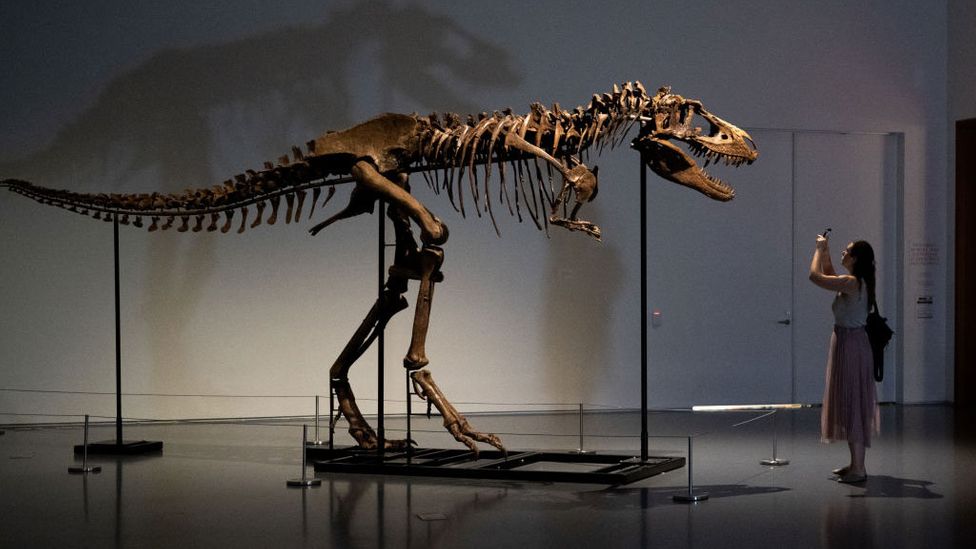
One reason that mammals outlived the dinosaurs is because they had adaptable diets (Credit: Getty Images)
Dinosaurs that made it through the earthquakes, fires and tsunamis soon found they had nothing to eat. Our mammalian ancestors, by contrast, lived on insects, nuts and aquatic (low-sunlight) plants. Only a small number of theropod dinosaurs – a clade that once included Tyrannosaurus rex and from which all contemporary birds evolved – managed to cling on thanks to their omnivorous diets, dextrous beak and a gizzard that helped them extract nutrition from seeds.
This lesson might suggest that we should prepare caches of basic emergency food. Indeed, in a testimony before the US Congress as the Cold War was heating up, US officials proposed an "all-purpose survival cracker" made from bulgur wheat, a substance whose "shelf life has been established by being edible after 3,000 years in an Egyptian pyramid." Cans of Campbell's soup, General Foods' Tang drink mix, and General Mills' "Multi-Purpose Food" (fortified dehydrated vegetables and soy grits) were all produced under government orders to line the shelves of fallout shelters.
Yet storing enough food to feed everyone for a decade – or even a year – would create problems of its own. It has been estimated that existing stores of dried food could feed around 10% of the global population for five years. If governments or the UN were to adopt the prepper mindset and produce the roughly 1.6 billion tonnes needed every year to feed all humans on Earth, prices would skyrocket. This too would be a catastrophe. We will need to find ways to grow food once again.
Underground farms
When the US detonated an atomic bomb above the Japanese city of Nagasaki, those who hid in old mine tunnels were able to survive so long as they weren't too near the entrance. In one famous case, 20-year-old Akiko Takakura held onto her life despite being within 300m (1,000ft) of the explosion hypocentre because she happened to be inside a reinforced concrete building – the Nagasaki branch of the Bank of Japan.
Faced with an asteroid strike, citizens in Ankara, Beijing, Moscow and Montreal will therefore have a head start. Each of these has large transit, storage, or commercial spaces deep underground – like uncanny inversions of the cities above. Turkey might even utilise the vast network of underground cities in Nevşehir Province, first constructed by the Phrygians 2,500 years ago, and expanded by Greek Cappadocians fearing persecution in the Byzantine era.
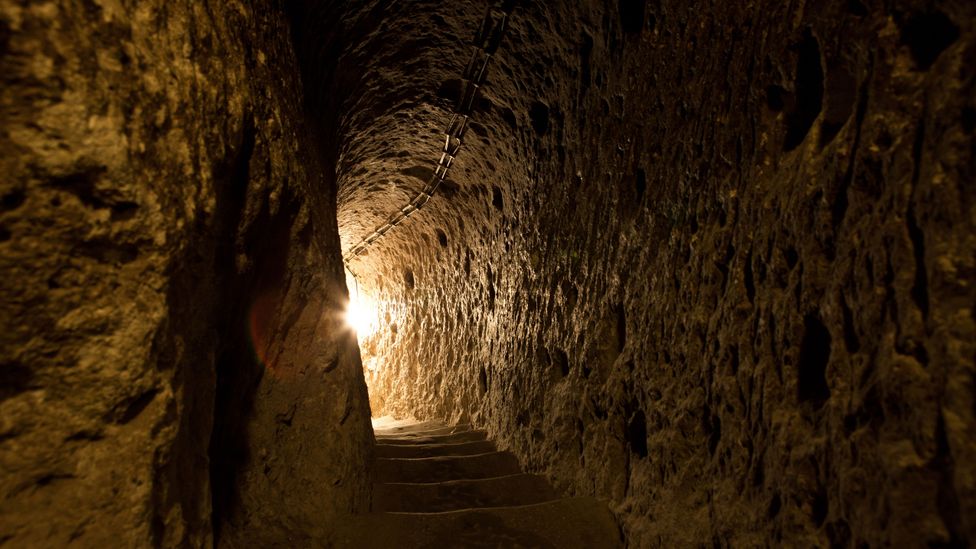
Underground settlements, like this one in Turkey, could be a suitable place to cultivate new types of crops (Credit: Getty Images)
The UK will be in a strong position too. Aside from underground train networks in London, Newcastle and Sunderland, Glasgow and Liverpool, there are subterranean vaults, shelters, caves and cellars in Nottingham, Edinburgh, Chislehurst and Stockport.
In addition to sheltering humans, subterranean spaces could be used to grow nutritious foods. Despite the lack of light, and the damp, poorly circulating air, certain crops can thrive here with the right approach. Thankfully, small-scale experiments in subsurface urban farming are already underway. For example, Paris harbours six sq km (2.3 sq miles) of untapped space in the form of redundant car parks, a portion of which the company Cycloponics has turned into mushroom farms. Meanwhile, the firm Growing Underground is cultivating vegetables in a former air raid shelter in Clapham, London.
For a short while, sprouts, microgreens, wheatgrass, white asparagus, rhubarb and mushrooms can be grown with either zero or minimal artificial light (many plants will germinate into seedlings without light, but will only develop so far). Sprouts are a great source of vitamins, fatty acids and fibres, and use energy stored in the seed to grow. The same is true of microgreens, which can provide a range of flavours – from spicy to sour to sweet – to garnish other foods.
None of these is a long-term solution, but we could use our time underground to start building one. In December 2020, the Coal Authority and British Geological Survey released heat maps for the estimated 25,000 sq km (9,650 sq miles) of disused coal fields across the UK, mostly in the English midlands, north, southern Wales and southern Scotland. The map is aimed at developers so future housing can be built to extract heat from the waters that returned to the mines after they were decommissioned. It might also prove useful for farming.
Ready meals
A week has passed. We climb out of our temporary refuge and witness a landscape we no longer recognise. Everything green is dying. Soot whirls in the air and the light is reminiscent of pre-dawn twilight, promising a brightness that never comes (or at least might take 5-10 years to arrive). We contact other survivors and agree that all knowledge and technology will be open sourced. We each have starter packs: bacteria, seeds, cells and spawn.
Since mushrooms do not contain chloroplasts – the tiny sunlight-powered factories in plants that convert CO2 into sugars – they do not need light to grow. What they require is warmth, moisture, and a substrate of organic matter on which to fruit, newly abundant in the felled vegetation of the old biological world.
Unfortunately, mushrooms are not a great source of calories. Many are poisonous. Most produce spores that are toxic to humans in high concentration and tear through buildings we'd prefer to use as shelter. Mushroom farming should take place in specially assigned basements, buildings and tunnels.
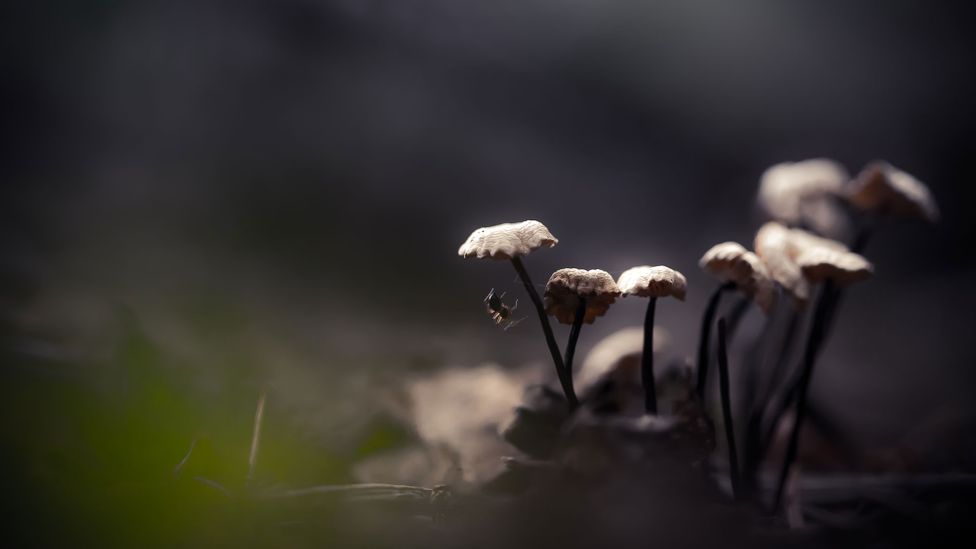
Mushrooms are a reliable food that grow without sunlight, but come with downsides (Credit: Getty Images)
It won't be easy to achieve a balanced diet – but it can be done. People will continue to eat surviving ruminant species like deer, cows, goats, and chickens, feeding the reduced number we keep on dead grasses, leaves, and decomposed wood.
As for tricky vitamins, E, A, and B12 can be synthesised by industrial processes. Others, such as K or D, will be more difficult to acquire. Most commercial vitamin D today comes from refining and radiating sheep's wool. In the short term, we can extract nutrients from flowers, leaves, and the non-woody parts of trees. Pine needle tea, for example, has many times the vitamin C of orange juice. Nettle tea contains vitamins A, C, and K, and dandelion tea is rich in potassium.
Computer models built to study all-out nuclear war – often used as an analogue for an enormous asteroid strike – predict that less than 40% of normal light will persist near the equator, with just 5% closer to the poles. Sugar beets have shown tolerance against lower temperatures, and we may have limited success growing carrots, cabbages, potatoes and peas.
Many more essential crops, such as potatoes, wheat, barley, rice, maize and soy could be relocated to the tropics and supplemented by cassava, baobab, wild spinach and yams, which are already there. Here we will build greenhouses – assuming that cooperation and trade remain possible – simple structures made from timber, polymer film, gravel and nails that maximise the sunlight we do receive.
Post-farm food
A common sight in cities today is rivers and canals choked with algae blooms. Yet this immense growing power could make algae highly valuable in a disaster. Species like chlorella and nannochloropsis, among others, are rich in nutrients, including rare omega-3 and omega-6 fatty acids, and can be grown in low light and harvested year round. One research paper noted the speedy recovery of phytoplankton after Chicxulub, a reminder of "the great resilience of the unicellular biosphere".
If farming algae in abandoned swimming pools, tanks, ponds and canals sounds like a solar punk daydream, well, it probably is. There are in fact other, more stable means to achieve our nutritional essentials. It's well known that algae thrives in cities due to fertiliser runoff from agriculture. Of the thousands of known species, many are toxic to humans and other animals. Perhaps in the future we might reframe this mishandling of chemistry and biology, and harness the process to use it deliberately instead.
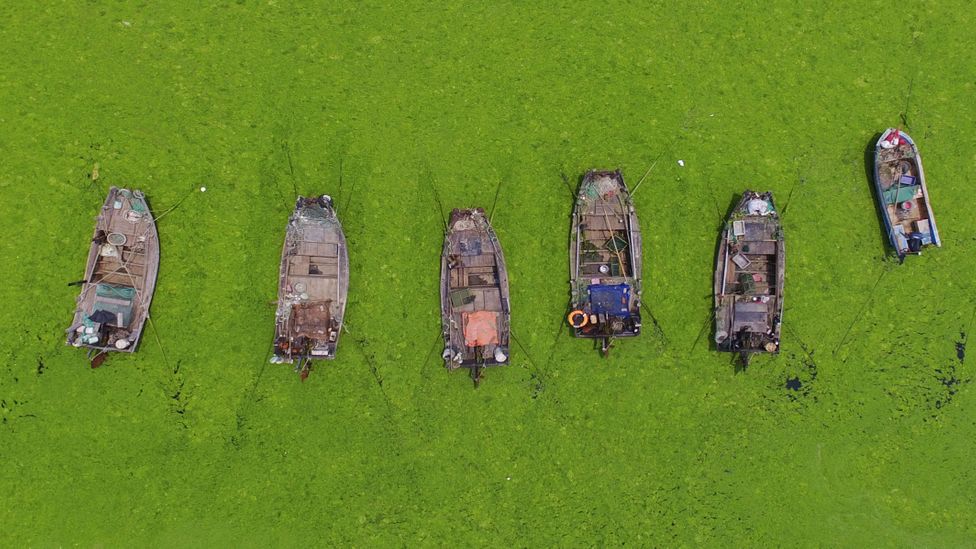
If algae growth could be harnessed safely, it could be a food source (Credit: Getty Images)
With feedstocks such as petroleum, natural gas, CO2, or the inedible parts of crops (the so-called residues leftover during harvesting or logging) we can produce "synthetic" proteins, sugar, and fats – all three human macronutrients. Last year, Nasa awarded three major prizes to teams pioneering the conversion of CO2 to sugar for use in future space missions.
Historically, in periods of war or economic crisis, infrastructure has been redirected to address society's most pressing needs. During World War Two, the US retrofitted 66% of automobile manufacturing to produce aircraft. And after the Covid-19 pandemic began in 2020, the clothing company Barbour made hospital gowns, and Land Rover reprogrammed its 3D printers from prototyping car parts to making protective visors.
Again, in the UK at least, the hottest action will be in the north. Biofuel refineries and paper mills in Selby, Grimsby, Wilton, Manchester and elsewhere could be repurposed to produce edible sugars from lignocellulosic biomass. One study found paper mills are in fact best suited to the job, boasting an 85% component match with a biochemical sugar plant.
Transforming hydrocarbons into waxes and digestible fats – literally turning fossil fuels into food – could help plug various shortfalls. It wouldn't be the first time. In the 1910s, the chemist Arthur Imhausen adapted a process known as paraffin oxidation to create butter aus kohle, or "butter from coal", in response to inflation in Germany. Another wartime innovation, culturing single-cell yeast proteins to feed soldiers, was adopted in Britain to produce an animal feed additive in the 1960s and ultimately became the meat-substitute Quorn.
Read more:
- How mammals won the dinosaurs' world
- The moments that could have accidentally ended humanity
- How to cope with the end of the world
A new plant in Chongqing, China uses a chemical synthesis process refined on Teesside to produce 20,000 tonnes of protein from bacteria. This single-cell protein requires only methane, oxygen and nitrogen to grow, and will be used to feed fish, but it could be adjusted to feed humans.
It may not sound especially delicious, but the most critical survival tool we have is one history suggests we can rely on – culinary innovation. Perhaps we can think of today's plant-based foods as a laboratory for fabrication – in which pea proteins replicate the fibrousness of meat or soy roots to make plant burgers "bleed." It's the continuation of a technology that has been utilised in all cultures to intensify flavour, make foods longer lasting, transform their shape, colour, texture, or to unleash psychoactive effects – fermentation. Results so far include bread, beer, kimchi, tempeh, soy sauce, wine, and cheese, as well as citric acid, ethanol fuel, and penicillin. The story is far from over.
The sea
It is difficult to predict what will happen to the oceans after the strike. Research into nuclear winter foresees acidification, increased UV, and collapsing food webs. Some argue that a well-managed "buffer", reducing current fisheries as the day of impact approaches, could provide us with a seafood frenzy when we need it most. Currently less than 2% of our calories come from the ocean. Only 22% of all seaworthy vessels are used for fishing. When the time comes, aircraft carriers, container ships, tug boats and yachts should be commandeered for aquaculture, using sea lanes devised for an entirely different purpose.
The offshore services company Roxel Aqua has devised a modular system (known as "the Octopus Concept") that converts drilling platforms into fish farms, and is seeking regulatory approval. Elsewhere, in the Gulf of Mexico, business and academia have collaborated on "integrated multi-trophic aquaculture" systems that use decommissioned oil rigs to farm mussels, finfish and kelp while also producing renewable energy.
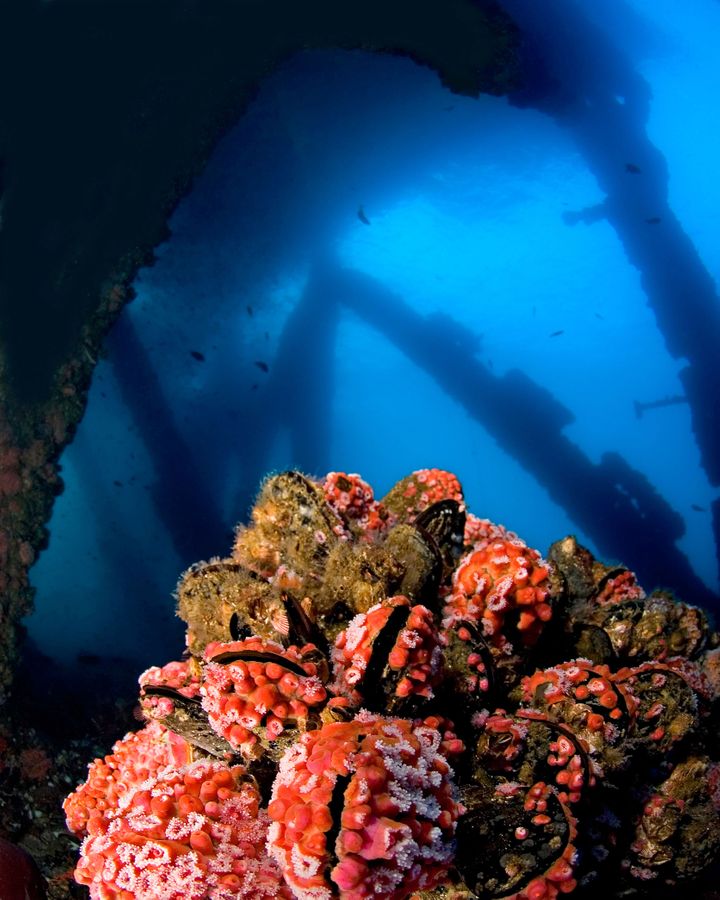
Life thriving below an oil platform (Credit: Alamy)
Seaweed grows in low light, meaning it can be protected from hazardous UV by submerging growing lines to greater depths. Species like wakame, kelp, emi-tsunomata and Welsh favourite laver are a more efficient machine, when compared to fish, for converting limited resources to valuable nutrition for humans.
Bivalves like clams, mussels and oysters are excellent sources of iron, the most common nutrient deficiency among humans worldwide. They grow in cramped spaces and do not suffer from lice and diseases as fish do. For another quick starter, wild sardines and anchovies are loaded with ever-scarce vitamin D. They also have the added bonus of maturing within six months and laying thousands of eggs.
Marine ecosystems flourish where hard, stable surfaces become available – on abandoned oil rigs. Aside from the plants, anemones, fish and seabirds that congregate around them, these platforms can host accommodation, silos filled with feed, gigantic holding pens and extremely long downlines for growing bivalves or seaweed. Most importantly, they are linked to onshore facilities once used for importing oil and gas. They are built to withstand bad weather: islands from the past from which we can stimulate regeneration in the seas. If the climate is cold enough – it's possible we could walk to the Douglas Complex off the coast of Liverpool and use its drill to access the bounty of the deep.
Cooking Earth
Nasa's recent success at altering the path of the asteroid Dimorphous is comforting, and researchers estimate the probability of a Chicxulub-sized collision at just 0.000001%. But that doesn't mean we shouldn't prepare for a catastrophic food supply collapse. After all, asteroids are not the only threat we face: there's also climate change, bio-terror, plant pathogens and ultra-resistant weeds, nuclear winter, and supervolcanoes.
In the future, we may need to loosen our idea of what farming looks like. Here I used an asteroid to do it – but art, commerce and science all have a role to play.
Our existing food system is held in place by government subsidies, corporate monopolies, and a cultural bias towards foods we perceive as being natural or traditional. Yet both man-made and natural disasters are inevitable. To prepare, we must reconsider the places and knowledge that may become viable when fields and sunlight no longer are: tunnels, mines, mills, factories and ocean platforms. This might not always seem palatable to some, but our species' survival may depend on it.
* Philip Maughan is a writer and researcher based between London and Berlin. He is a co-founder of the food research platform Black Almanac.
Further reading:
- The Knowledge, about how we might bounce back from a global disaster.
- Feeding Everyone No Matter What, a guide to post-catastrophe food production.
--
Join one million Future fans by liking us on Facebook, or follow us on Twitter or Instagram.
If you liked this story, sign up for the weekly bbc.com features newsletter, called "The Essential List" – a handpicked selection of stories from BBC Future, Culture, Worklife, Travel and Reel delivered to your inbox every Friday.
How an asteroid impact would transform the food we eat - BBC
Read More

No comments:
Post a Comment